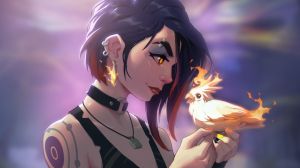Star Wars: The Last Jedi makes some big changes to the franchise lore, and very little of it resembles the popular fan theories that were debated throughout the wait time between Episode VII and Episode VIII.
Videos by ComicBook.com
One of the big theories going into The Last Jedi was that the title and narrative themes being teased in trailers could lead to the introduction of a new type of Force warrior, The Gray Jedi. Clearly that didn’t happen – but here’s why not going the route of the Gray Jedi may have been a big missed opportunity for The Last Jedi‘s narrative and thematic arc.
Balancing Act
The first half of The Last Jedi sees Rey on the island of Ahch-To, where she tries to goad Luke Skywalker into teaching her the ways of the Jedi. While on Ahch-To, Rey is aware of and even lured to both the light and dark sides of The Force; when Luke tries to teach her to sense The Force all around her, Rey also senses something else: the balance.
Indeed, the weight of light against dark, in the notion of striking balance between these two ideas, is a major thematic motif of The Last Jedi. Whether its Kylo Ren’s internal conflict, or the sermon of Benicio Del Toro’s DJ about how “good guys” and “bad guys” are naive concepts, The Last Jedi is grasping for something beyond the concepts of the past. And yet, by the end, the movie seems to revert back into tradition: Kylo Ren becomes the fallen Jedi in full, Rey is the new hope, etc. It’s a fine rehash of Empire Strikes Back, but could’ve been something more, if one or both characters had to walk some new middleground.
Meaningful Message

The Last Jedi has plenty of meaningful themes, which carry some fine messages. The cameo from Yoda reinforces the theme that failure, when understood, can be the best teacher; Luke, Kylo, and Rey’s storyline reinforces the theme of why holding onto the past too tight can be damaging. Best of all, Rey’s origin and that endearing final epilogue with a young boy both reinforce the idea that a Jedi hero can be anyone, from any little corner of the galaxy, and not just someone with Skywalker blood. While all of the above are timeless themes of literary tales (especially “a hero’s journey” tales), they aren’t necessarily as timely as they could’ve been.
Like the Prequel Trilogy, The Last Jedi isn’t afraid to inject timely political metaphors into its story – most noticeably in the whole Canto Bight sequence, where Finn and Rose take a shot at the galactic 1% by doing some Green Peace-style animal rescue / anarchy. And yet, in skipping over the introduction of the Gray Jedi concept, The Last Jedi misses out on what could be a very timely exploration of political divisiveness, and how/why to bridge it.
If anything, the specious notion that a person can be all light or all dark is the kind of simplistic thinking that we need to move past as a society. It’s a concept that could be reflected in the story of a hero who acknowledges his/her power in full complexity, and demonstrates the discipline of managing that balance.
Girl Power

It’s a real shame that we don’t get a more complex application of The Jedi concept as we finally have more great Star Wars female heroes that could serve as the perfect embodiments of an expanding and more nuanced concept of The Force, and how it relates to the self.
Having a storyline where a bigger concept of The Jedi religion is discovered because of the perceptions and understandings of a female Jedi, would’ve been a bold move that elevated Rey from being a novelty to being a statement about the power of female intuition and rationale, as compared to men. Oddly enough, those sort of gender-based differences are smoothly woven into the Resistance storyline of The Last Jedi, with Poe and Finn both having their perceptions of what it means to fight back, hold on to hope, and “resist,” being re-aligned by the brave and powerful women around them (Rose, Leia, Holdo).
And yet, for Rey, we end up getting the same old Jedi tale as Luke, only adding fuel to those who criticize that the choice in going with a heroine over a hero is just a cosmetic one.
The Last Hope

It should be stated that The Gray Jedi are not entirely out of the picture… yet. Star Wars: Episode IX still has to bring the story of Rey and Kylo Ren / Ben Solo to a close, and could do so in a very “Gray Jedi” way.
The Last Jedi basically kills off the idea of The Jedi and Sith as we know them (that whole “kill the past” theme), setting the stage for a new era and definition of who the lighsaber-wielding Force warriors are. It’s a concept that could easily slide back into something like “Knights of Ren vs. New Jedi,” or we could get another twist and see Ben/Kylo find a different sort of redemption.
Kylo has always been presented as this conflicted characters of both light and dark – maybe Episode IX doesn’t have to end with a predictable “bad guy dies” ending. Kylo has come to far to ever be redeemed as servant of the light, but he could still balance the darkness in his soul (Vader’s legacy) by remembering the light his parents represented (Han and Leia’s legacy). It would be interesting if this sequel ended with the epilogue of Kylo Ben (see what I did there) heading off into the galaxy to find his place as a Force warrior his neither light or dark but both. It would be a nice introduction of the concept into the movie franchise, and a good set up for that Kylo Ren standalone film we want.
Do you want to see the Gray Jedi in the Star Wars movie universe, or do you wish fans would stop bringing it up? Let me know @KofiOutlaw – and rate The Last Jedi for yourself below:








